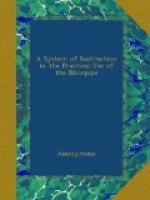The bead should first be submitted to the oxidation flame, and any reaction carefully observed. Then the bead should be submitted to the flame of reduction. It must be observed that the platinum forceps should not be used when there is danger of a metallic oxide being reduced, as in this case the metal would alloy with the platinum and spoil the forceps. In this case charcoal should be used for the support. If, however, there be oxides present which are not reduced by the borax, then the platinum loop may be used. Tin is frequently used for the purpose of enabling the bead to acquire a color for an oxide in the reducing flame, by its affinity for oxygen. The oxide, thus being reduced to a lower degree of oxidation, imparts its peculiar tinge to the bead as it cools.
The arsenides and sulphides, before being examined, should be roasted, and then heated with the borax bead. The arsenic of the former, it should be observed, will act on the glass tube in which the sublimation is proceeding, if the glass should contain lead.
It should be recollected that earths, metallic oxides, and metallic acids are soluble in borax, except those of the easily reducible metals, such as platinum or gold, or of mercury, which too readily vaporize. Also the metallic sulphides, after the sulphur has been driven off. Also the salts of metals, after their acids are driven off by heat. Also the nitrates and carbonates, after their acids are driven off during the fusion. Also the salts of the halogens, such as the chlorides, iodides, bromides, etc., of the metals. Also the silicates, but with great tardiness. Also the phosphates and borates that fuse in the bead without suffering decomposition. The metallic sulphides are insoluble in borax, and many of the metals in the pure state.
There are many substances which give clear beads with borax both while hot and cold, but which, upon being heated with the intermittent oxidation flame, become enamelled and opaque. The intermittent flame may be readily attained, not by varying the force of the air from the mouth, but by raising and depressing the bead before the point of the steady oxidating flame. The addition of a little nitrate of potash will often greatly facilitate the production of a color, as it oxidizes the metal. The hot bead should be pressed upon a small crystal of the nitrate, when the bead swells, intumesces, and the color is manifested in the surface of the bead,
6. EXAMINATIONS IN MICROCOSMIC SALT.
Microcosmic salt is a better flux for many metallic oxides than borax, as the colors are exhibited in it with more strength and character. Microcosmic salt is the phosphate of soda and ammonia. When it is ignited it passes into the biphosphate of soda, the ammonia being driven off. This biphosphate of soda possesses an excess of phosphoric acid, and thus has the property of dissolving a great number of substances, in fact almost any one, with the exception




